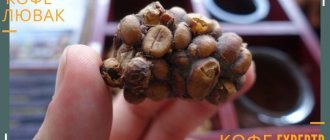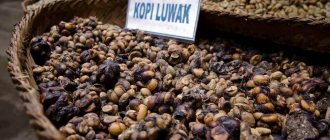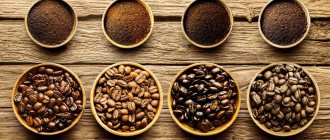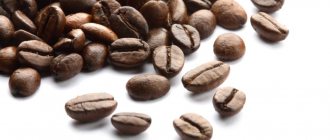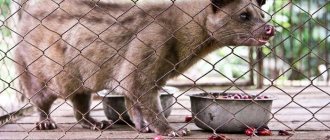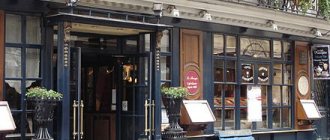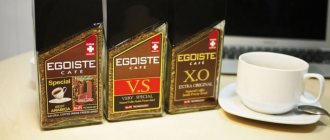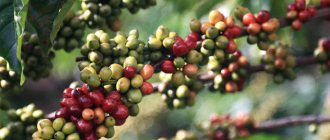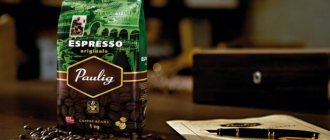Coffee has never been a cheap product. History remembers the times when coffee beans were worth their weight in gold. And this is not an exaggeration.
Europeans, having found a “gold mine”, began to actively develop plantations with coffee trees around the world in the middle of the 18th century, where only the climate allowed them to do this: in Colombia and Mexico, India and Indonesia.
Coffee became cheaper, but still brought enormous profits to those in whose hands were its production and sales. You can read about how and where coffee is grown in the world here.
Even today, there are varieties that are available only to a few due to their high cost . We are no longer talking about coffee as such, but about the exclusivity of certain types of raw materials, unusual methods of obtaining and processing them, and the significant expenses associated with this.
A list of all coffee varieties with names and their characteristics can be found in this article.
A review of the most expensive tea in the world can be found here.
Blue Bourbon (from $70 per kg)
Let's start with the innocent Blue Bourbon , which originates in Rwanda. For 1 pound of grains, manufacturers ask up to $35, and considering that 1 pound is equal to 453 grams, a kilogram will cost the buyer more than $70.
Experts characterize Blue Bourbon as a drink with a slight sourness, a very sweet base and a light vanilla aftertaste.
Unfortunately, many people sell cheap varieties under the guise of “Blue Bourbon”, relying on inexperienced customers, so it is very important to check the authenticity when purchasing.
Dark Tusk
Another product that can challenge the title of the most expensive coffee in the world is Dark Tusk. It is created in Thailand and 3 regions in the Maldives. Already from the name it is clear which animal is a fundamental link in the coffee production chain. This is an elephant. He is also not averse to eating coffee berries.
The development of coffee production is similar to the Indonesian Accumulate Luwak. The elephant eats grains, or rather berries, which undergo a kind of fermentation when passing through the digestive tract. Then they are extracted from the feces, washed, dried and fried. Digested grain in a volume of 1 kg is obtained from more than 30 kg of berries.
The drink prepared from the same grains has a rich fruity taste and aroma, it contains floral, chocolate and nutty notes all at once. There is no bitterness in it, and there is no sourness. It is affectionate and soft, as befits a good Arabica. In the world, this type of coffee is known as Black Ivory; its cost reaches 500–600 bucks per 500 grams.
Kona (from $75 per kg)
Kona Coffee , grown in Hawaii, has a similar price It's not as common as others, so you can't buy it everywhere, but if you're lucky enough to vacation on the islands, it's definitely worth a try (be prepared for the fact that it will still be expensive).
The price and unusual taste are due to the fact that it is grown on volcanic soil, which is rich in a variety of minerals.
Accumulate Luwak
In most rankings, the most expensive coffee in the world is Accumulate Luwak. Its main producers are Indonesia, Vietnam, South India and the Philippines. There are small Arabica plantations growing at an altitude of more than 1500 m above sea level.
A small rodent also lives here - a civet or luwak, as the local inhabitants call it. Specifically, he is the main person in the chain of transformation of ordinary coffee berries into elite and expensive coffee.
Take this test and find out which drink is best for you.
The animal is kept in a zoo and once a day processes several kilograms of ripe and not only coffee berries. Its maintenance is not so inexpensive for farmers, because for normal life it needs meat. The rodent is nocturnal, so feeding occurs late in the evening and early in the day. To get 50 g of coffee beans ready for processing after the beast, you need to feed it about 1 kg of berries.
Apart from this, the luwak must definitely be released, because it does not breed in captivity. Later they are captured again and placed in a zoo.
How is coffee processed from animal feces obtained?
- Plantation workers collect animal poop once a day and send it to dry.
- After that, the grains are washed under running water and separated from the poop.
- Next comes the process of drying the grains.
- The final step is roasting.
Usually, coffee beans are roasted to a medium degree, because the future drink should taste soft with an almost imperceptible bitterness. Coffee made from roasted beans has a chocolate-caramel flavor and vanilla aroma. Nowadays, a lot of Accumulate Luwak comes from Vietnam. In recent years, this country has become one of the global favorites for coffee sales in general.
What explains such a high price for Luwak coffee? Apart from the cost of caring for plantations and paying workers, farmers need to maintain wild animals that require care, and this is a considerable expense. Apart from this, the output comes out with an even smaller number of good coffee beans than if they were simply collected and dried. Advertising praising the unusual taste of the drink also adds weight to the cost.
Los Plains (from $80 per kg)
El Salvador is one of the largest coffee exporters in Latin America, but its products have long had a bad reputation. This was not due to the low quality of the coffee itself, but to the political situation in the country: sanctions, restrictions and general instability caused suppliers to be physically unable to deliver fresh coffee.
In recent years, the situation in this regard has improved significantly, so Los Plains can now be found of high quality. The price, however, has also increased: if previously 1 kg would have cost 40-50 dollars, now you have to pay all 80.
Everything has its price
Research shows that during the digestion process, elephant enzymes break down the protein in coffee beans. Since protein is one of the main factors responsible for the bitterness of coffee, low protein levels indicate a lack of bitterness. But everything has its price.
Black Ivory coffee processed by elephants sells for US$1,100 per kilogram or US$50 per cup and is one of the most expensive coffees in the world.
For comparison, civet coffee costs around US$500-600 per kilogram or US$30 per cup. Civet coffee is coffee processed by cats and produced using the same technology - the animal eats coffee beans, the proteins are destroyed during digestion.
At Anantara Hotel, guests who order a cup of Black Ivory will see the beans harvested from which they will be served a unique drink in a traditional coffee balancing siphon.
Eight percent of all coffee sales go to the Thailand Elephant Foundation.
Hacienda Santa Ines (from $100 per kg)
The elite variety Fazenda Santa Ines is grown in Brazil, and the collection technology is far from modern. All grains are collected by hand, and then they are sorted by hand, leaving only the best grains. This is carefully monitored, since reputation plays a huge role for the manufacturer.
Refusal to use technology and constant monitoring at all stages are the reason for such a high price.
The chocolate taste with notes of citrus goes perfectly with milk, so lovers of pure black coffee may not appreciate the drink.
What animals “make” elite varieties of coffee?
Most elite varieties of coffee can be obtained by humans with the help of animals. Some of them have unique extrasensory perception and can find the finest grains. The most famous helpers in this matter are lemurs, monkeys, bats and even elephants. From an aesthetic point of view, many find it difficult to drink a drink made from grains that were once in animal droppings. However, coffee lovers claim that the taste of such drinks is amazing and incomparable to anything else. Knowing which animal feces make delicious coffee, it’s easier to navigate prices and product names.
Ate Ingerto (from $110 per kg)
It is grown in Guatemala, where humidity remains high most of the year. It is the climate that helps create the flavor range of El Injerto, which no other country can replicate.
“El Ingerto” regularly takes prizes at world coffee exhibitions and competitions, which helps to increase its popularity around the world.
Notes in famous magazines and word of mouth spread rumors about him to the most remote corners of the world.
Who invented exotic coffee?
In the near future, we are unlikely to find out who was able to come up with such an exotic method of processing coffee berries. There are various legends, obscure stories and common tales associated with this issue.
The most plausible version is the following story. Colonizers on the Sumatra Peninsula, after the musang population increased greatly and the animals began to quickly eat the berries, introduced a tax on coffee. But someone saw grains in animal droppings and decided to dry them and then fry them. This discoverer came up with a good drink, which soon became known, but a tax on poop was not introduced. From now on, the story of this unusual drink begins, which, despite the title of the most expensive coffee in the world from the litter, not everyone agrees to try.
Coffee made from animal feces: all about the most expensive coffee in the world made from animal droppings.
Coffee has never been a cheap product. History remembers the times when coffee beans were worth their weight in gold. And this is not an exaggeration.
Europeans, having found a “gold mine”, began to intensively develop plantations with coffee trees around the world in the middle of the 18th century, where only the climate allowed them to do this: in Colombia and Mexico, India and Indonesia.
Coffee became cheaper, but still brought enormous profits to those in whose hands were its creation and marketing. You can read about how and where coffee is grown in the world here.
Even today, there are varieties that are available only to a few due to their high prices. We are no longer talking about coffee as such, but about the exclusivity of certain types of raw materials, unusual methods of obtaining and processing it, and the significant waste associated with this.
Find a list of all types of coffee with names and their characteristics in this article.
A review of the most expensive tea in the world can be found here.
Coffee from St. Helena Island (from $250 per kg)
St. Helena Island is a picturesque place and popular among tourists. People come here not only for the coffee: here is the house where Napoleon Bonaparte lived, as well as the valley where he was buried.
The volcanic origin and geographical remoteness allow the island to preserve virgin forests in which many rare plants grow.
The coffee of the same name is grown on several small plantations, so local producers can compete with other brands only on the basis of price and quality, but not on the basis of volume.
The most expensive and delicious coffee in the world
It is very similar to another variety of coffee, Kopi Luwak, which is obtained from the excrement of musang animals. However, the elephant's stomach has a slight advantage in this regard.
On average, it takes an animal about 15-30 hours to digest coffee fruits
, which are simmered with bananas, sugar cane and other ingredients of a typical vegetarian elephant diet to create a uniquely rich and fruity flavour.
A rare type of coffee can be tasted only at four resorts in the world: three in the Maldives and one in Thailand, and a cup of this drink is not cheap - $50
.
Why is it so expensive, you say? Firstly, keeping elephants in a reserve is expensive. Secondly, the elephants are fed only Thai Arabica coffee grown at an altitude of 1500 meters. In addition, elephants need to eat about 32 kg of coffee fruits to produce 1 kg of coffee beans
.
Blue Mountain (from $700 per kg)
Blue Mountain coffee is also called “royal”, paying tribute to its taste. The tart nutty aroma and slight sourness are not capable of surprising anyone, but the blue-green hue of the grains immediately attracts attention.
The trees grow on plantations high in the mountains, where not only the climate is special, but also the soil. Gourmets call “Blue Mountain” one of the most unusual varieties, as its taste does not change even with heavy roasting.
The most expensive coffee in the world - top five
“Black Tusk” is a unique, rare, and most expensive coffee in the world. Finding it, let alone buying it, is very difficult. Counterfeits are more common on store shelves.
Do you want to know more information about what is the most expensive type of coffee in the world after what is described above? Explore our list of the most elite varieties that can actually be purchased in our country. So, here are the five most expensive products, arranged in order of increasing cost.
Coffee Geisha (Geisha)
Its price varies between 10-11 thousand rubles per thousand grams of fried product. The history of the origin of this variety is quite interesting; to this day no one can say with certainty where it came from. According to some researchers, plant seedlings were brought from Ethiopia, from the village of Geisha, which is why coffee is called that. But in modern Ethiopia it was never possible to find a similar variety.
Geisha began to actively gain popularity among coffee lovers in the twentieth century. It was then that farmers in South America decided that this variety was resistant to rust, which, at that moment, was the enemy of any coffee tree. But the hopes were not justified, plus the plant turned out to be extremely capricious and had absolutely no intention of adapting to the climate of the plains. Therefore, they stopped breeding it.
In 2003, the owner of the Panamanian coffee farm Hacienda La Esmeralda found several trees of the described variety on his land, and in the same year he won a prestigious coffee competition with these beans. Rumor has it that one of the experts tried the prepared drink and found it divine, exclaiming “God in cup!”
After this, the victorious Geisha began to march majestically around the world. This coffee differs from others in its clean and expressive bouquet, in which you can feel interspersed with notes of citrus, lime, berries and lychee flowers. The drink has a soft, enveloping taste and leaves a delicate, long aftertaste.
This type of coffee is grown not only in Panama. Today there are several Geisha plantations. The most expensive grains are Hacienda La Esmeralda, costing from 11-12 thousand rubles per kilogram. It can be found on store shelves under the name La Esmeralda.
You can also purchase an analogue from Costa Rica. It is sold on shelves under the Geisha TM, and costs up to 10,000 rubles per kilogram.
Although the Geisha variety is not the most expensive coffee in the world, it is the winner of various competitions and has entered the history of coffee discoveries of the twenty-first century.
Jamaican Blue Mountain Coffee
This type of coffee is abbreviated as JBM. Its cost reaches 27 thousand rubles. per kilogram of roasted grain.
The coffee plantation where the plant is grown is located in the very center of the island of Java, on the slopes of a mountain range. Its main peak is known as Blue Mountain, hence the name of the variety.
Due to the fact that this area combines a special set of climatic factors, such as altitude above the sea, soil composition and sea wind, the coffee turns out to be extremely tasty. Its bouquet is considered the most exquisite on the planet. It combines three tastes: bitterness, sourness and sweetness. As for the aftertaste, it is famous for its long-lasting nutty notes. In the bouquet you will feel the aroma of ripe nectarines.
Producers of the variety consider it very important that it has stable quality. This is facilitated by the constancy of the climate, the absence of sudden changes in temperature and atmospheric pressure. As a result, it is possible to obtain grain with the intended taste characteristics.
Jamaican Blue Mountain is grown in limited quantities; the total weight of coffee beans is fifteen tons per year.
Be careful when purchasing this type of coffee. There are several other regions on the planet where it is also grown. But there are no such unique natural conditions as on the island of Java, and therefore the taste bouquet of this product is completely different.
Remember that a genuine product is always accompanied by a special certificate of conformity, which is issued by the Government of Jamaica to the buyer.
In addition, original coffee is supplied to the coffee market not in bags, but in special barrels. The Jamaican drink is one of the most delicious, although it is not the most expensive coffee in the world.
Brazilian variety Jacquou Bird
The cost of this coffee ranges from 28 to 30 thousand rubles per 1 kilogram of finished beans. The variety is rare and exotic, growing in the southeastern part of Brazil.
Since about the 60s of the last century, the coffee plantations on the Kamotsim Estate farm have become sites for recreating the local natural landscape. Here the trees are grown together with other forest and fruit species. They are cared for exclusively using organic methods.
Thanks to this, it was possible to achieve not only a high-quality restoration of the fertile soil layer, but also the development of the local fauna. The area is home to active breeding of birds called Jacu. They are similar to Russian guinea fowl, even in plumage and color.
During the period when coffee berries are ripening, birds willingly eat them, leaving some trees without any fruit at all. At first, these birds were looked at as pests and considered arrogant invaders.
The current owner of the farm decided to approach the problem from a different angle. Now the birds have lost their status as pests and have become collectors of precious berries. The bottom line is that the birds digest the pulp and the grains are excreted naturally. After which the owner of the plantation collects them, washes and dries them.
Jacques Bird has a very expressive nutty flavor combined with a hint of rye bread. When consuming it, you will experience exotic notes of fruit and a pleasant smell of black molasses. This type of coffee is considered one of the rarest, and therefore costs a lot of money. The plantation produces no more than two tons of grains per year.
Coffee Bat, Costa Rica
The cost of such coffee ranges from 30 to 32 thousand rubles per 1 kilogram of finished beans. It grows in the southeast of Costa Rica, in the highlands. The production is carried out by a coffee farm called Cofea Deversa. Its owner calls his wealth a coffee garden.
The peculiarity of the area is that a population of bats lives next to it. From generation to generation, she flies to the plantation to taste the ripe coffee berries.
In fact, the animal is not able to swallow a whole berry. He just bites the skin and sucks out the sweetest pulp. As a result, the trees are decorated with grains in the shell. They dry on the branches, naturally, for several days, then they are removed, cleaned and dried again. This is how we get a unique, although not the most expensive coffee in the world, called Bat.
Due to the fact that two drying methods are used in coffee production, dry and wet, and the beans are selected most accurately, it is possible to achieve an amazing, unique taste. The fact is that bats have very sensitive olfactory and sensory apparatus, and therefore feast on only the best fruits.
In the bouquet of this type of coffee you can feel the sweetish notes of nectarine and coconut milk, as well as the aroma of amazing spices. The multi-layered aftertaste reveals an accent of chocolate, nuts and exotic shades of fruit.
In just a year, about several hundred kilograms of this coffee are harvested.
Indonesian variety Kopi Luwak
The cost of such coffee reaches 35 thousand rubles per kilogram of roasted beans. This variety is considered partially fermented. The fermentation process takes place in the civet's digestive tract. After the grain undergoes such a unique processing, its taste becomes soft and chocolatey, with a slight taste of groundnuts. The fermentation process involves lactic acid bacteria, which break down the proteins of coffee beans, thereby removing the bitterness we are accustomed to.
Coffee is produced in several regions of the planet. Plantations are found in the Philippines, India, and China. The most popular is the Indonesian variety Kopi Luwak, which grows in Java, Sulawesi and Sumatra.
There are two ways to get Kopi Luwak. On special plantations where civets are kept, feeding them picked coffee berries, or in wild conditions, in which the animals themselves choose what to eat.
The price of grains depends on where they were grown and how they were obtained. The most expensive is the wild variety of coffee, which is of Indonesian origin. Small lots of one hundred grams will cost you a little more than a kilogram package.
Farm-grown Indonesian Kopi Luwak is much cheaper, its price ranges from 23 to 25 thousand per kilogram of roasted grain. If the variety is grown not in Indonesia, but on a farm, you can buy it from 20,000 rubles per kilogram, but you are unlikely to find it cheaper. By the way, you can drink the most expensive coffee in the world with excellent coffee!
Kopi Luwak is the most expensive coffee in the world, but not on the planet as a whole, but among those varieties that are available for free sale.
Incredible facts
The most expensive coffee in the world, called "Black Tusk", is made from coffee beans eaten and digested by Thai elephants, and costs $1,100 per kilogram.
.
According to those who have tried coffee, the exotic drink made from elephant excrement has a rich, smooth taste
precisely thanks to the digestion process in the elephant's intestines.
“When an elephant eats coffee beans, the acid in its stomach breaks down the proteins in the coffee, which gives the drink a bitter taste,” the experts explained. “The result is coffee with a very mild taste without bitterness
regular drink."
Kopi Luwak made from musang dung (from $800 per kg)
Luwak is the most popular variety of elite coffee, constantly mentioned in literature and cinema. Thus, Jack Nicholson’s hero in the comedy “Until I Played the Box” constantly drank this drink, having no idea about the method of its manufacture, and Morgan Freeman’s hero laughed at it, knowing all the intricacies.
The Malayan palm civet, also known as the musang, feeds on coffee beans that end up on the shelves after being in their stomachs.
In the body of the musang, coffee is impregnated with special enzymes, due to which it acquires a truly unique taste. There are practically no side unpleasant odors.
Only 500 kg of Kopi luwak are produced annually, most of which goes to regular customers. It is difficult to buy at least 50 grams not only because of the price of $70, but also because of the banal shortage of the drink on the market.
An interesting and sad fact: unscrupulous producers force-fed musangs grains in order to obtain “Kopi Luwak”, while keeping the animals in unsanitary conditions. Because of this, they are listed as protected in India, and some subspecies are included in the International Red Book.
How to cook properly
There is a traditional way to brew the drink.
1-2 tsp. The ground product is poured into a metal glass, at the bottom of which there is a sieve. The glass is placed on another container and the product is poured with boiling water. The liquid seeps through a sieve into a container located under a metal vessel. The drink should be infused for at least 15-20 minutes before drinking.
In European countries, another brewing method has become widespread:
- The grain product is ground in a coffee grinder before use.
- Almost any container can be used for brewing. However, Kopi Luwak fans recommend using a silver-plated copper pot.
- Heat the container over low heat for 1-2 minutes.
- Pour 1 tsp into the prepared Turk and removed from the heat. product (for preparing 1 serving).
- The next step is to add salt at the tip of the knife. This ingredient will not affect the taste of the drink. Salt is needed to form and preserve the foam.
- Pour 1 glass of cold water into the Turk. It is advisable to use bottled rather than tap water.
- Place the drink on low heat and cook until foam appears. In order not to spoil the taste, it is necessary to remove the Turk from the heat at the first sign of boiling.
Indonesians add large amounts of sugar to luwak. However, it is advisable to drink an exotic drink without this ingredient in order to feel its unusual taste. Also, do not use cognac, liqueur, milk or cream. Luwak is not used to make coffee-based drinks such as lattes or cappuccinos.
Interesting! Espresso coffee: what is it really?
Blue Mountain Coffee from Jamaica
This coffee is obtained using the usual method. But everything influences the taste: the unique composition of the earth, the direction of the winds, and the placement of plantations. The grains mix different tastes - from bitterness to sweetness and sourness. The smell of the drink is unusual and reminiscent of the smell of new nectarines. More than 85% of the product produced in Jamaica is sold in the Land of the Rising Sun, so purchasing such a drink in our country is problematic. In addition, 1 kg of finished raw materials costs about 27 thousand rubles. Not many people manage to experience all the exotic types of coffee. Apart from the cost, there is a great danger of purchasing a fake. Therefore, it is better to try such a drink in the countries where it is created.
Origin of Luwak coffee
The most expensive coffee in the world began to be sold at the end of the 19th century. The emergence of this drink is presumably due to the fact that the Dutch, in whose hands were entire coffee plantations, forbade local residents to drink it. But they were not at all confused and found a way to circumvent the ban by making a drink fermented by the inhabitants of the local fauna.
This was exactly the drink that “good Europeans” would never even taste. The title itself suggests that animals play a major role in the production of this drink, specifically the wild civet or luwak, as these animals are called in their homeland.
In appearance, the animals resemble a weasel, a marten, or even a cat. The natural habitat of these animals is the forests of Southeast Asia, Sri Lanka and southern China. Luwak is a predator that prefers to eat not only small amphibians or insects, but also various fruits and berries. But the most important delicacy for this animal remains the fruits of the coffee tree.
The most expensive coffee is produced in several places in Indonesia, but Bali remains the most famous. And here we are not talking about the quality of the product at all. Bali is still considered a place where crowds of tourists from all over the world go with great enthusiasm to the most widespread resorts on this island, ready to buy coffee made from excrement for fabulous sums.
But the most expensive coffee in the world may not always turn out to be real; only a real gourmet will be able to distinguish real animal Luwak coffee from a fake. Not only is Bali famous for its high-quality fakes made from dung; coffee in Vietnam, on the Java Peninsula or in Sumatra also does not always correspond to the declared price.
